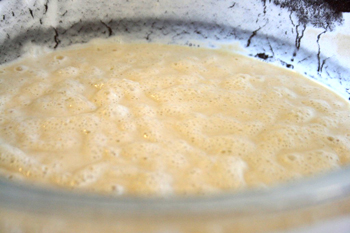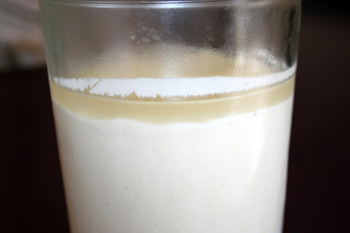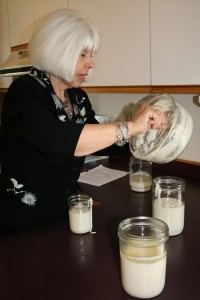 Janice Buckner, of Fargo, North Dakota, has a personality that matches the sourdough starter she has kept alive for over 35 years – it bubbles. I know, it’s hard to believe. Who has time to monkey around with a bubbling mixture of flour and milk, giving it regular feedings and making sure it has plenty of rest time on the kitchen counter?
Janice Buckner, of Fargo, North Dakota, has a personality that matches the sourdough starter she has kept alive for over 35 years – it bubbles. I know, it’s hard to believe. Who has time to monkey around with a bubbling mixture of flour and milk, giving it regular feedings and making sure it has plenty of rest time on the kitchen counter?
I had my first conversation with sourdough queen, Janice Buckner, by phone. Her voice bubbled with enthusiasm as she told me about her mysterious sour substance that has produced coffee cakes that have made her famous with friends and co-workers over the years.
Janice Buckner received her starter from a friend when she lived in Idaho. It was over 98 years old at that time. When she and her husband moved to Fargo in 1976, the beloved living organism made the long car trip sealed tightly in a jar.
Friends and co-workers of the Buckner’s have enjoyed sourdough coffee cakes studded with berries or layered with apple slices to celebrate birthdays. Sourdough English muffins have been formed, baked and packaged in the Buckner kitchen for holiday gift-giving. Sourdough French Bread is a favorite accompaniment to meals served at the Buckner’s dining table.
According to Yvonne Young Tarr in the “New York Times Bread and Soup Cookbook,” the traditional sourdough starter of pioneer lore, which gold prospectors and lumberjacks utilized for making bread rise, is merely fermented dough made by combining equal amounts of flour and milk. When placed in a glass jar or ceramic bowl for several days and kept warm, the milk’s natural organisms launch a bacterial fermentation action in the mixture. The starter will begin to bubble and sour, which you can see and smell, if all goes well.
At this point the starter is ready to use. Store leftover starter in the refrigerator, covered. Be sure to restore the starter to its original volume each time you use some for baking. Add equal amounts of milk and flour to your depleted supply. Allow the starter and its added ingredients to remain overnight at room temperature to bubble and sour again.
 If you want to make your own starter from scratch, pour 1 cup milk in a glass jar or ceramic bowl. Leave uncovered at room temperature for 24 hours. Blend in 1 cup all-purpose flour. Set the uncovered mixture to rest in a warm spot, but not too warm, or no fermentation will take place. About 80 degrees F. is the correct temperature. Allow to stand for several days, or until it begins to bubble and sour.
If you want to make your own starter from scratch, pour 1 cup milk in a glass jar or ceramic bowl. Leave uncovered at room temperature for 24 hours. Blend in 1 cup all-purpose flour. Set the uncovered mixture to rest in a warm spot, but not too warm, or no fermentation will take place. About 80 degrees F. is the correct temperature. Allow to stand for several days, or until it begins to bubble and sour.
Cover and store in the refrigerator until ready for use. Sourdough starter improves with age, but try to use it at least once a week, and restore it to its original volume each time you use it by adding equal amounts of milk and flour.
In 1973, the folks at Sunset perfected a process for developing a sourdough starter that included a little low-fat plain yogurt mixed in with the flour and milk. After a few days of incubation, bacteria in the yogurt multiply to give typical sour smell and flavor, and the starter is ready to use. You can get instructions for the Sunset method at this link: Sourdough Starter ’73.
Sourdough starter is available in some grocery and specialty stores or online at King Arthur Flour. A live starter and a dehydrated San Francisco Sourdough starter are available at Amazon.
I met Janice Buckner at her home for a sourdough starter tutorial. She took an afternoon break from her job at State Bank & Trust to teach me all I need to know to keep a portion of her ancient starter alive.
 I learned sourdough starter should be kept in a glass container. No plastic allowed. Foreign bacteria could be hiding out in the plastic, with potential to kill the sourdough starter.
I learned sourdough starter should be kept in a glass container. No plastic allowed. Foreign bacteria could be hiding out in the plastic, with potential to kill the sourdough starter.
It’s not uncommon for liquid to form on the top of the starter. If it is relatively clear, it is normal. Just stir it back into the starter. If is is pink or orange – done. It’s contaminated. Time to start over.
Use metal utensils when working with the starter. Keep wooden spoons and rubber spatulas in the drawer. They can breed foreign bacteria that is not good for healthy starter. Healthy sourdough starter will be full of bubbles. When you leave it on the counter, be sure to use a glass bowl that allows plenty of room for growth.
Starter should be fed with equal amounts of flour and skim milk at least once a week. Each time you remove some of the starter to use for baking or sharing, replace it with equal amounts of flour and milk. The starter will be have a thick consistency, similar to pancake batter.
 Her obsession with the fermenting concoction prompts Buckner to keep an extra jar or two of starter in the refrigerator. This allows for a backup in case, heaven forbid, some starter dies. It also allows her to have some starter ready to share if anyone is interested. Unfortunately, she hasn’t had many takers.
Her obsession with the fermenting concoction prompts Buckner to keep an extra jar or two of starter in the refrigerator. This allows for a backup in case, heaven forbid, some starter dies. It also allows her to have some starter ready to share if anyone is interested. Unfortunately, she hasn’t had many takers.
She’s had many requests for her coffee cake recipe. Once the cake-lovers find out they need to have some of the sourdough starter, they quickly lose interest. One person who eagerly took a jar of the starter said, “I feel like I have a new pet!”
I’ve had my new pet for over 2 weeks. It’s still alive. I’ve made Janice Buckner’s famous sourdough coffee cake with apple slices layered over the top. You can get that recipe in my column this week.
I’ve made sourdough pancakes. They are light and fluffy with just a slight tang that pairs well with butter and honey or maple syrup. Next up on my sourdough to-do list is Sourdough French Bread.
A whole new baking world has opened up in my kitchen. Sourdough starter is the start of many good things – as long as you keep it alive. I must keep this living beneficial bacteria-loving, bubbling fermentation alive. Janice Buckner and her husband will be moving to Maine at the end of this month. A tightly sealed jar of sourdough starter will make the long car trip to its new home.
A trip to Maine for more starter could be an option for me – but, only if I catch the sourdough starter obsession from Janice Buckner.
Sourdough Pancakes
1 cup all-purpose flour
1/4 cup sugar
2 teaspoons baking powder
1/4 teaspoon baking soda
1/2 teaspoon salt
1/4 cup canola or vegetable oil
1 cup sourdough starter that has been sitting on counter overnight
1 egg, beaten with a fork
Milk to thin
Sift flour, sugar, baking powder, baking soda and salt into glass mixing bowl. Use a fork to mix in oil. The mixture will be crumbly. Add sourdough starter and mix lightly. Add beaten egg and stir to blend. Add milk until mixture is proper consistency for pancakes. Pour onto lightly greased hot griddle. Cook until bubbles form on batter and edges are cooked. Flip and cook until pancakes are brown and cooked completely.
Makes about 8 (5- to 6-inch) pancakes.
Sue Doeden is a popular cooking instructor, food writer and integrative nutrition health coach. She is the host of Good Food, Good Life 365 on Lakeland Public Television. Her own hives full of hardworking bees and her love of honey led to the creation of her recently published cookbook, Homemade with Honey.

